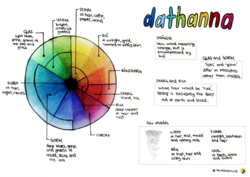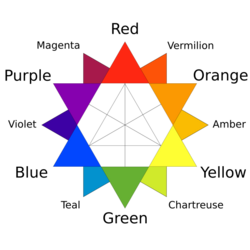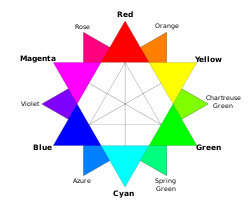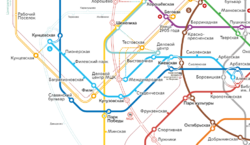Color term
A color term (or color name) is a word or phrase that refers to a specific color. The color term may refer to human perception of that color (which is affected by visual context) which is usually defined according to the Munsell color system, or to an underlying physical property (such as a specific wavelength of visible light). There are also numerical systems of color specification, referred to as color spaces.
An important distinction must be established between color and shape, as these two attributes usually are used in conjunction with one another when describing in language. For example, they are labeled as alternative parts of speech terms color term and shape term.[1]
Psychological conditions for recognition of colors exist, such as those who cannot discern colors in general or those who see colors as sound (a variety of synesthesia).
Color dimensions
Typical human color vision is trichromatic, meaning it is based on a three-dimensional color gamut. These three dimensions can be defined in different ways, but often the most intuitive definition are the dimensions of the HSL/HSV color space:

- Hue: representing the different colors of the rainbow or color wheel (e.g. 'red', 'orange', 'yellow', etc.); roughly analogous to the color's wavelength or frequency.
- Saturation: the colorfulness of the color, i.e. a measure of vibrant vs. pale.
- Luminosity: a measurement of intensity or 'brightness'.
In natural languages
Lexicology
Monolexemic color words are composed of individual lexemes, or root words, such as 'red', 'brown', 'fuchsia' or 'olive'. The root words generally describe the hue of the color, but some root words - namely brown - can also describe the other dimensions. Compound color words make use of prefix adjectives (e.g. 'light brown', 'sea green'), that generally describe the saturation or luminosity or compounded basic color words (e.g. 'yellow-green'), which refine the hue of the color relative to root words. 'Vaaleanpunainen', the Finnish word for 'pink' is a clear agglutination of the language's words for 'pale' ('vaalea') and 'red' ('punainen').
Basic color terms
Basic color terms meet the following criteria:[2]
- monolexemic ('green', but not 'light green' or 'forest green'),
- high-frequency, and
- agreed upon by speakers of that language.
English has 11 basic color terms: 'black', 'white', 'red', 'green', 'yellow', 'blue', 'brown', 'orange', 'pink', 'purple', and 'grey'; other languages have between 2 and 12. All other colors are considered by most speakers of that language to be variants of these basic color terms. A useful litmus test involves replacing each of these basic terms with an approximation of other basic terms, e.g. replacing orange with red-yellow. If the approximation is jarring, the replaced term likely meets the requirement for being a basic color term. An example of a color that comes close to being a basic color term in English is turquoise. It is monolexemic, but is not very high frequency, especially compared to alternatives teal or cyan. It also generally fails the above litmus test in that most people do not find the use of the approximation of other basic color terms (blue-green) to be jarring.
Color term hierarchy
In the classic study of Brent Berlin and Paul Kay (1969), Basic Color Terms: Their Universality and Evolution,[2] the researchers argued that the differences in number of basic color terms in languages follow a repeatable pattern. Color terms can be organized into a coherent hierarchy and there are a limited number of universal basic color terms which begin to be used by individual cultures in a relatively fixed order. This order is defined in stages I-VII. Berlin and Kay originally based their analysis on a comparison of color words in 20 languages from around the world. The model is presented below, broken into stages, with stage I on the left and stage VII on the right:[3]
[math]\displaystyle{ \begin{Bmatrix}\text{white} \\ \text{black} \end{Bmatrix} \lt \text{red} \lt \begin{Bmatrix}\text{green} \\ \text{yellow} \end{Bmatrix} \lt \text{blue} \lt \text{brown} \lt \begin{Bmatrix}\text{purple} \\ \text{pink} \\ \text{orange} \\ \text{grey} \end{Bmatrix} }[/math]
Berlin and Kay's study identified seven stages of color distinction systems. Each progressive stage features a color term that the previous stages do not.
Stage I (dark and light)
| Stage I[4] | light–warm (white / yellow / red) dark–cool (black / blue / green) |
|---|
Stage I contains two terms, white and black (light and dark); these terms are referenced broadly to describe other undefined color terms. For example, the Jale highland group in New Guinea identify the color of blood as black. This is because blood, as a relatively dark liquid, is grouped into the same color classification as black.
In the Bassa language, there are two terms for classifying colors; ziza (white, yellow, orange and red) and hui (black, violet, blue, and green).[5]
In the Pirahã language, there appear to be no color terms beyond describing lightness and darkness.[6]
The Dani language of western New Guinea differentiates only two basic colors: mili for cool/dark shades such as blue, green, and black; and mola for warm/light colors such as red, yellow, and white.[7][8]
Stage II (red)
| Stage II[4] | white red / yellow black / blue / green |
|---|
Stage II implements a third term for red. Objects begin to rely less on their brightness for classification and in this stage we instead see each term cover a larger scope of colors. Specifically, blue and other darker shades continue to be described as black, yellow and orange colors are classified with red, and other bright colors continue to be classified with white.
In the Bambara language, there are three color terms: dyema (white, beige), blema (reddish, brownish) and fima (dark green, indigo and black).
Stage III/IV (yellow + green)
| Stage III[4] | white red yellow black / blue / green |
white red yellow / green / blue black |
white red / yellow green / blue black |
|---|
Stage III identifies a third term referring either to green (IIIa) or yellow (IIIb). Most languages in the study with this system identify yellow over green, such as the Komi language, where green is considered a shade of yellow (виж, vizh), called турун виж (turun vizh): 'grass yellow'.[9] However, the Nigerian Ibibio language and the Philippine Hanunoo language both identify green instead of yellow.
The Ova-Himba use four color names: zuzu stands for dark shades of blue, red, green, and purple; vapa is white and some shades of yellow; buru is some shades of green and blue; and dambu is some other shades of green, red, and brown.[10] It is thought that this may increase the time it takes for the Ova-Himba to distinguish between two colors that fall under the same Herero color category, compared to people whose language separates the colors into two different color categories.[11]
| Stage IV[4] | white red yellow green black / blue |
white red yellow green / blue black |
|---|
Stage IV incorporates green or yellow, which ever was not already present, i.e. stage IIIa languages will adopt yellow and stage IIIb languages will adopt green. Most stage IV languages continue to colexify blue and green, as listed in Blue–green distinction in language.
The Chinese character 青 (pronounced qīng in Mandarin and ao in Japanese) has a meaning that covers both blue and green. In more contemporary terms, they are 藍 (lán, in Mandarin) and 綠 (lǜ, in Mandarin) respectively. Japanese also has two terms that refer specifically to the color green, 緑 (midori, derived from the classical Japanese descriptive verb midoru 'to be in leaf, to flourish' in reference to trees) and グリーン (guriin, which is derived from the English word 'green').[citation needed]
Stage V (blue)
| Stage V[4] | white red yellow green blue black |
|---|
Stage V introduces blue as its own color term, differentiating from black or from green.
Stage VI (brown)
The seventh basic color term is likely to be brown.
In English, this is the first basic color term (other than black and white) that is not differentiated on hue, but rather on lightness. English splits some hues into several distinct colors according to lightness: such as red and pink or orange and brown. To English speakers, these pairs of colors, which are objectively no more different from one another than light green and dark green, are conceived of as belonging to different categories.[2]
Stage VII
Stage VII adds additional terms for orange, pink, purple or grey, but these do not exhibit the same hierarchy as the previous seven colors.[12]
English contains eleven basic color terms: 'black', 'white', 'red', 'green', 'yellow', 'blue', 'brown', 'orange', 'pink', 'purple', and 'grey'.
Stage VII+
Languages with further color distinction use relativistic light / dark terms like light blue / dark blue (in comparison to blue sky / blue ocean), or pale red / deep red.
Italian, Russian and Hebrew have twelve basic color terms, each distinguishing blue and light blue. A Russian will make the same red / pink and orange / brown distinctions, but will also make a further distinction between sinii and goluboi, which English speakers would call dark and light blue. To Russian speakers, sinii and goluboi are as separate as red and pink, or orange and brown.[13]
Hungarian and Turkish distinguish multiple words for 'red': piros and vörös (Hungarian; vörös is a darker red), and kırmızı, al, and kızıl (Turkish); kırmızı now includes all reds but originally referred to crimson, to which it is cognate, while kızıl mainly refers to scarlet and other orange-tinted or brownish reds. Two words for 'red' are also found in Irish and Scottish Gaelic: (dearg for light, bright red and rua or ruadh respectively for dark, brownish red). Turkish also has two words for 'white' (beyaz and ak) and 'black' (siyah and kara). Ak and beyaz have the same meaning, while kara is a broader term than siyah and also includes dark browns; which word is used also depends on the kind of object being described. Both Ak and kara are of turkic origin, while siyah is borrowed from Persian, and beyaz from Arabic bayāḍ بياض.
In Serbian/Croatian language there are differences in dark brown (mrk), brown (smeđ & kestenjast), red (crven), pink (ružičast) and orange (narandžast), as well as in blue hues: very dark blue or blue-green (teget), dark blue (modar), blue (plav) and ash blue (sinj).
An interesting case that deviates from this pattern is Irish's two words for green:
- glas denotes the green color of plants
- uaine denotes artificial greens of dyes, paints etc.
This distinction is made even if two shades are identical. Glas is also used for "natural" greys, such as the grey squirrel, iora glas.[14][15]
Linguistic relativity
These colors roughly correspond to the sensitivities of the retinal ganglion cells, leading Berlin and Kay to argue that color naming is not merely a cultural phenomenon, but is one that is also constrained by biology—that is, language is shaped by perception.[2] A 2012 study[16] suggested that the origin of this hierarchy may be tied to human vision and the time ordering in which these color names get accepted or agreed upon in a population perfectly matches the order predicted by the hierarchy.
Non-hue terms
This article mostly describes the color terms that define the hue of a color, since hue is considered the most innate dimension of the three. However, other terms are often used to describe the other two dimensions, which can be seen as common prefixes to the root terms that generally describe hue. Adding prefixes to root color terms generates multilexemic colors. Examples of common prefix adjectives can be seen in a list of color names and are described:
- Brightness: can describe either high luminosity or high saturation, according to the Helmholtz–Kohlrausch effect and/or Hunt Effect.
- Lightness: describes both a high luminosity and low saturation
- Darkness: the opposite of lightness, or low luminosity
- Paleness, dullness: a measure of desaturation
- Deep, Royal: may refer to darkness and/or high saturation; unrelated to color depth.
- Pure, Bold, Vivid, Rich: all referring to high saturation
- Pastel: refers to colors with high luminosity and low saturation.
- Neon: bright, in either of the word's connotations; alluding to the bright glow of neon lighting.
- Fluorescent: very bright, sometimes also highly saturated. Named after the fluorescence effect of pigments and dyes, which can produce a luminous glow when viewed under UV light, thereby appearing significantly brighter than their surroundings.[17]
Non-dimensional terms
Other terms sometimes used to describe color are related to physical phenomenon that do not describe a single color, but describe the dynamic nature of an object's color. These include:
- Glossy: whether the surface reflects diffusely or specularly (sharply)
- Metallic: distinguishing 'gold' and 'silver' from shades of 'yellow' and 'grey', respectively
- Iridescent: dependence of color on viewing angle, innate to structural coloration
- Opacity: opaque (solid) vs. translucent (transparent or see-through)
Abstract and descriptive color terms
Color terms can be classified as abstract or descriptive, though the distinction is often unclear.
Abstract color terms only refer to the color they represent and any etymological link to an object of that color is lost. In English white, black, red, yellow, green, blue, brown, and grey are abstract color terms. These terms are also basic color terms (as described above), though other abstract terms like maroon and magenta are not considered basic color terms.
Descriptive color terms are secondarily used to describe a color but primarily refer to an object or phenomenon. 'Salmon', 'rose', 'saffron', and 'lilac' are descriptive color terms in English because their use as color terms is derived in reference to natural colors of salmon flesh, rose flowers, infusions of saffron pistils, and lilac blossoms respectively.
Abstract color terms in one may be represented by descriptive color terms in another; for example in Japanese pink is momoiro (桃色, lit. 'peach-color') and grey is either haiiro or nezumiiro (灰色, 鼠色, lit. 'ash-color' for light greys and 'mouse-color' for dark greys respectively). Nevertheless, as languages evolve they may adopt or invent new abstract color terms, as Japanese has adopted pinku (ピンク) for pink and gurē (グレー) for grey from English.
While most of the 11 basic color terms in English are decidedly abstract, three of them (all stage VII, so understandably the youngest basic color terms) are arguably still descriptive:
- Pink was originally a descriptive color term derived from the name of a flower called a 'pink'. However, because the word 'pink' is rarely used to refer to the flower anymore, relative to its common usage as a color, it is often regarded as an abstract color term.
- Purple is another example of this shift, as it was originally a word that referred to the dye named Tyrian purple, which took its name from the latin purpura, which referred to both the dye and the sea snail from which the dye was derived. However, this etymological link has been lost in translation.
- Orange is difficult to categorize as abstract or descriptive because both its uses, as a color term and as a word for an object, are very common and it is difficult to distinguish which of the two is primary. As a basic color term it became established in the early to mid 20th century; before that time artist's palettes called it 'yellow-red'. In English, the use of the word 'orange' for a fruit predates its use as a color term. The word comes from French orenge, which derives via Arabic narand͡ʒ and Sanskrit narang from a Dravidian language such as Tamil or Tulu.[18] The derived form orangish as a color is attested from the late 19th century[19] by reference to the fruit.
Struggle in linguistics
Research on color terms is often conducted without reference to common uses of the term or its significance within the context of its original language. In John A. Lucy's article The linguistics of 'colour' he identifies two key categories. One of these is 'characteristic referential range', or the use of a color term to identify or differentiate a referent over a wide context.[1]
Standardized systems
In contrast with the color terms of natural language, systematized color terms also exist. Some examples of color naming systems are CNS[20] and ISCC–NBS lexicon of color terms. The disadvantage of these systems, however, is that they only specify specific color samples, so while it is possible to, by interpolating, convert any color to or from one of these systems, a lookup table is required. In other words, no simple invertible equation can convert between CIE XYZ and one of these systems.
Philatelists traditionally use names to identify postage stamp colors. While the names are largely standardized within each country, there is no broader agreement, and so for instance the US-published Scott catalogue will use different names than the British Stanley Gibbons catalogue.
On modern computer systems a standard set of basic color terms is now used across the web color names (SVG 1.0/CSS3), HTML color names, X11 color names and the .NET Framework color names, with only a few minor differences.
The Crayola company is famous for its many crayon colors, often creatively named.
Heraldry has standardized names for 'tinctures', subdivided into 'colors', 'metals', and 'furs'.
See also
- Lists of colors
- Color wheel
- Lazarus Geiger
- How the Himba see green and blue
References
- ↑ Jump up to: 1.0 1.1 Davidoff, Jules (1997). Colour Categories in Thought and Language; "The neuropsychology of color". Cambridge, England: Press Syndicate of the University of Cambridge. pp. 118–120. ISBN 9780521498005.
- ↑ Jump up to: 2.0 2.1 2.2 2.3 Berlin, Brent; Kay, Paul (1969). Basic Color Terms: Their universality and evolution.
- ↑ Kay, Paul; McDaniel, Chad (1978). "The Linguistic Significance of the Meanings of Basic Color Terms". Language 54 (3): 610–646. doi:10.1353/lan.1978.0035.
- ↑ Jump up to: 4.0 4.1 4.2 4.3 4.4 Kay, Paul; Maffi, Luisa (1999). "Color appearance and the emergence and evolution of basic color lexicons". American Anthropologist 101 (4): 743–760. doi:10.1525/aa.1999.101.4.743.
- ↑ McNeill, N. B. (28 November 2008). "Colour and colour terminology". Journal of Linguistics 8 (1): 21–33. doi:10.1017/S002222670000311X.
- ↑ Kay, Paul. (2007). Pirahã Color Terms. Retrieved 17 March 2019.
- ↑ Saunders, Barbara Ann Christine (January 1, 1992). The Invention of Basic Colour Terms. R.U.U.-I.S.O.R.. ISBN 9789051870879. https://books.google.com/books?id=Fl8gAQAAIAAJ&q=mili+mola++.
- ↑ Heider, Eleanor Rosch (1972). "Probabilities, Sampling, and Ethnographic Method: The Case of Dani Colour Names". Man 7 (3): 448–466. doi:10.2307/2800917. http://www.jstor.org/stable/2800917.
- ↑ Rueter, Jack M. (1996), Komia-anglisköĭ-finsköĭ
- ↑ Roberson, Debi; Davidoff, Jules; Davies, Ian R.L.; Shapiro, Laura R. (January 2006). "Colour categories and category acquisition in Himba and English". in Pitchford, Nicola; Biggam, Carole P.. Progress in Colour Studies. II Psychological aspects. John Benjamins Publishing Company. pp. 159–172. doi:10.1075/z.pics2.14rob. ISBN 978-90-272-3240-3. https://www.researchgate.net/publication/43627151. Retrieved 2012-05-28.
- ↑ Reiger, Terry; Kay, Paul (28 August 2009). "Language, thought, and color: Whorf was half right". Trends in Cognitive Sciences 13 (10): 439–446. doi:10.1016/j.tics.2009.07.001. PMID 19716754. http://www1.icsi.berkeley.edu/~kay/tics2.pdf. Retrieved 2012-08-29.
- ↑ Varley, Helen, ed (1980). "The Vocabulary of Color". Color. London: Marshall Editions. pp. 50–51. ISBN 0-89535-037-8.
- ↑ "Seeing the blues". Nature. 2007-04-30. http://www.nature.com/news/2007/070430/full/news070430-2.html.
- ↑ Séaghdha, Darach Ó (January 20, 2019). "The Irish For: How many colours can you remember?". https://www.thejournal.ie/readme/the-irish-for-colours-you-may-have-forgotten-lots-of-your-schooling-but-you-should-remember-the-word-bandearg-4447647-Jan2019/.
- ↑ Glasgow, Gaelic Society of. "Transactions of the Gaelic Society of Glasgow ...". https://books.google.com/books?id=gnQ9AAAAYAAJ&q=uaine+glas+distinction.
- ↑ Loreto, Vittorio; Mukherjee, Animesh; Tria, Francesca (2012). "On the origin of the hierarchy of color names". Proceedings of the National Academy of Sciences 109 (18): 6819–6824. doi:10.1073/pnas.1113347109. PMID 22509002. Bibcode: 2012PNAS..109.6819L.
- ↑ Schoonmaker, David (May–June 2006). "Sunshine on a cloudy day". American Scientist 94 (3): 217. doi:10.1511/2006.59.217. https://www.americanscientist.org/article/sunshine-on-a-cloudy-day.
- ↑ "orange, n.1 and adj.1". Oxford English Dictionary. Oxford University Press. June 2012. http://www.oed.com/view/Entry/132163. Retrieved 2012-09-04.
- ↑ Oxford English Dictionary, 'orangish'
- ↑ Berk, T.; Brownston, L.; Kaufman, A. (1982), "A New Color-Naming System for Graphics Languages", IEEE Computer Graphics and Applications, 2, IEEE, pp. 37–44
External links
- The Colour of Words – Article on Color Names
- Coloria.net: Color names
- Japanese Colour Names Cheat Sheet
- Japanese Traditional Color Names
- Japanese colors with English names
- Inter-Society Color Council
- The color names in CSS 3: Color Module and SVG
- Survey of color dictionaries
- An Online Colour Naming Experiment
- Colour Words in Many Languages
- Test your own color terms
- SpoonFlower color map
- Color Method
- i.stack.imgur basic color terms
- HTML Color Picker
 |





